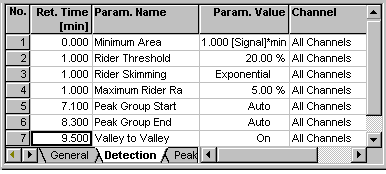
Defining Detection Parameters
The Detection Parameters define how the chromatograms are integrated, in which areas peaks are suppressed, how peak starts and peak ends are detected, etc. Thus, the detection parameters allow you to adapt the integration to your requirements and to minimize the re-integration effort for individual chromatograms.
You can either enter the detection parameters in the table on the Detection tab page of the QNT Editor or define them graphically in a chromatogram.
The detection parameters influence the integration of all chromatograms to which the selected QNT Method applies. They can assume new values at any time. Only the value that was defined last will take effect, however, only for the time of the chromatogram. The parameters are reset to their default values afterward. If a parameter assumes a new value at a specified time (Retention Time column), this is called an Event. You do not have to enter these events in chronological order. They will be sorted automatically when being saved. The Channel column allows you to define whether this applies to an individual channel only or to all channels (default) of a sample.
Each detection parameter has a default value assigned. Using this value, the system automatically integrates about 90% of all chromatograms correctly. However, for critical applications, such as wavelength switching, the user can influence the baseline or the peak type, for example, rider peak or main peak, or disable detection for defined periods.
Parameter tables can include up to 100 lines. For an example of how to enter detection parameters in the table of the Detection tab page, refer to the following image:

In many cases, it may be easier to enter the detection parameters graphically in the chromatogram (see How to …: Working with Chromatograms ![]() Defining Detection Parameters Graphically).
Defining Detection Parameters Graphically).
Usually, the chromatogram and the report table are immediately updated when the detection parameters have been changed. However, you may disable this function by deselecting Autom. Re-Integerate on the View menu of the QNT Editor. If this option is disabled, save the QNT Method or select Start Integration on the View menu to start re-integration with the new integration parameters.
![]() Tip:
Tip:
Save the setting for this option in the corresponding Report Definition File (Select Save Report Definition on the Workspace menu.)
In addition, the QNT Editor provides more detection parameters. The following sections describe how to edit the default values together with the respective possibilities and advantages. Use the detection parameters for:
![]() Reducing the Number of Evaluated Peaks
Reducing the Number of Evaluated Peaks